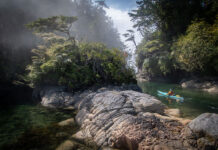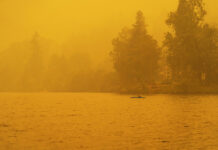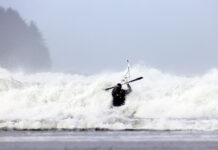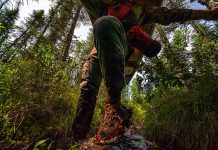Whenever I stop for gas with a sea kayak on my car, I get the same questions. “Is sea kayaking relaxing? Is it scary? Can you camp out of that thing?” The answer, of course, is yes, yes, and yes. All in a single trip. The sea kayak is the most versatile of human-powered vessels. A single craft that can handle glassy mirrors, the churn of rock gardens and long expeditions on exposed coasts. I’ve even taken my fiberglass sea kayak down class II rivers. However, that same flexibility has made sea kayaking hard to define. It’s impossible to convey the joys and challenges of a sport so complex and diverse. Usually I babble up a bunch of stories until the gas station attendant’s eyes glaze over. Then I pay, get back in my car and leave.
Not exactly attracting new blood to the fold.
Even the term sea kayaking confuses people. Salt isn’t the determining factor of our sport: we take our sea kayaks many places that aren’t the sea. Is kayak touring a better term for what we do? Perhaps, but that always implies place- to-place movement, a kind of backpacking on the sea. That’s not always true, and doesn’t begin to hint at the dynamisms of the environment. Backpacking trails don’t build into steep cresting waves when the wind rises or the tide turns. Meadows don’t harbor invisible currents, which can deflect course by a mile. When weather turns for the worse on a backpacking trip it adds discomfort but seldom poses danger.
Does sea kayaking have an identity crisis? Only if its greatest advocates can’t even properly describe what it is.
To explain what is at the heart of the sport I turn to the legendary dirtbag Fred Beckey. As Beckey explained to the New York Times back when he was a young chap of 85: “You’ve got to be physically pretty strong to be any good at it at all. You’ve got to have a hard-core mental attitude. You’ve got to have the right mantra. You’ve got to have dedication, a sense of security, safety and sensitivity with your partners, and a good sense of balance. It’s a combination of many, many things. You need to have the capability or desire to accept a certain amount of risk. A lot of it is maybe spiritual, not a religious type, but you have to have an affinity with the outdoors.” Sounds like a good explanation of the varied world of sea kayaking to me. But Beckey wasn’t describing sea kayaking. In fact, I don’t know if he’s ever been in a kayak at all.
Beckey’s a legend of old school alpinism. As I write these words, he’s still climbing at 93. Old school alpinism involves backpacking to scale remote mountains using a variety of techniques. There’s a lot of simply walking with a pack for a long ways. Once at the mountain, alpinists are faced with mixed terrain: rock, ice, cracks, ridges and glacier travel. Alpinism is a mix of steady-burn endorphins, flashes of adrenaline, continually watching the weather and route conditions, all the while reveling in wild remoteness. It’s equal parts endurance, technical skill, judgment, love of wilderness and raw desire to do strange and challenging things in remote places. Sound familiar?
Sea kayaking is traditional alpinism on the sea. In a week of paddling, there will be a lot of simple repetitive forward strokes to get from point A to point B, infused with a perpetual awareness of weather and currents and changing conditions that an alpinist would be proud of. Exposed crossings, tide races, surf zones and boomer fields are our headwalls, crevasses, and knife-edged ridges. Our base camps are storm-wracked beaches at Cape Scott instead of alpine cols. Crux moves are similar: a stretch of exposed sea cliffs can be a lot like one of Beckey’s high alpine traverses in commitment, required skill and raw wildness.
Subtract any one of these four elements—endurance, wilderness, technical skill or judgment— and we lose something. No endurance and we’ll lose access to remoteness. We’ll share beaches with surfers, kite-fliers and golden retrievers instead of whales and wolves. Subtract the wilderness and we’ll have the sea kayaking equivalent of whitewater park-and-play: exercise and skill but not the soul-deep connection to nature. Subtract the technical skill and we’ll be avoiding conditions, limiting our destinations and the margin of error. Lose the judgment and we’ll become fools who rush in where angels—and Coast Guard helicopters—may fear to tread.
In the years since Beckey’s climbing heyday, traditional alpinism has mostly given way to sport climbing, which removes the long slogs up ridges with a heavy pack but subtracts the wilderness. And in climbing’s indoor stepchild, the rock gym, the weather is controlled by the HVAC system and the condition of the route is managed by gym staff. With shorter vacations and busy lives giving way to more day trips and park-and-play surf breaks, kayaking is going through a similar transition.
Sea kayaking, like Beckey’s alpinism, includes all of it. When sport climbing hit the climbing world, the remaining alpinists quickly found they had the remote mountains to themselves again. If you can keep your chart-reading, route planning and boat handling skills up to snuff, so too can you.








